Espresso Brined Tri-tip Smoked with Pecan
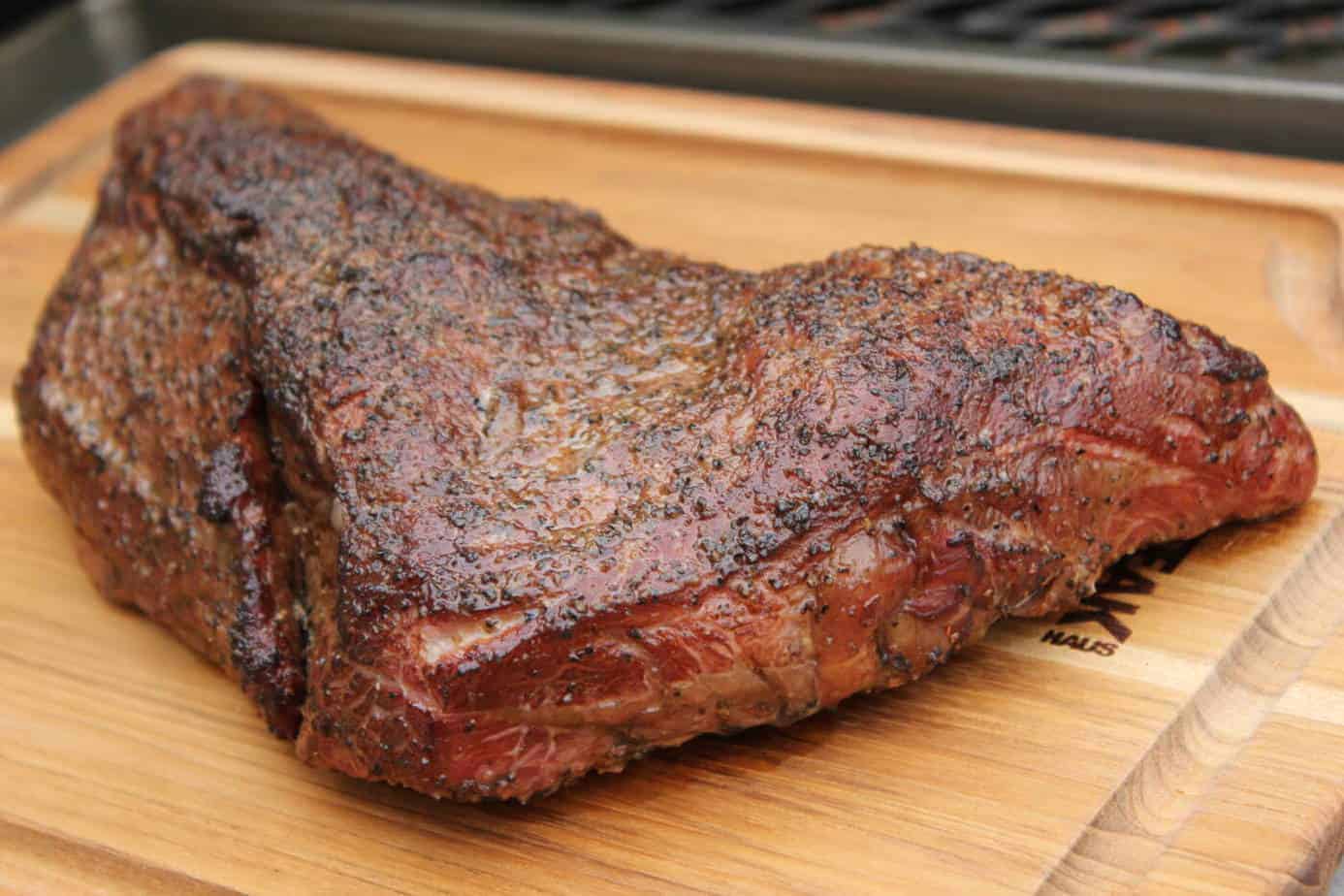
Smoking-Meat.com is supported by its readers. We may earn an affiliate commission at no extra cost to you if you buy through a link on this page.
Read this article without ads
Smoked tri-tip is one of my favorite cuts of beef that I cook on the smoker. It is tender, delicious and doesn’t take a long time to prepare. In this version, I used an espresso brine that incorporates coffee as well as a touch of cocoa to really make that delicious beef flavor pop. The salt in the brine, as with all brines, helps to bring out the natural flavors of the meat. I think you’re going to like this one a lot!
And of course, my Texas style rub is the magic that flavor the meat and creates that beautiful crust on the outside
- Prep Time: 15 minutes
- Brine Time: 3 hours
- Cook Time: 2 hours
- Smoker Temp: 225-240°F
- Meat Finish Temp: 130°F
- Recommended Wood: Red oak, Oak and/or Pecan
- 1 or more tri-tip roasts. (usually 2.5 to 3 lbs each)
- Espresso brine (recipe below)
- Jeff's Texas style rub
- 1 stick (¼ lb) butter
A tri-tip will usually have a fat cap on one side. If the butcher has not already trimmed this down or removed it, you can do this yourself using a very sharp knife.
Sometimes I remove it and other times I leave it alone. Either way, it's not a problem.
As you can see there's plenty of fat marbling so that's what will keep the meat moist during the cooking process.

Brine ingredients
- 4-5 cups coffee (about a quart)
- ¼ cup kosher salt
- 2 TBS cocoa (unsweetened)
- 1 TBS red pepper flakes
Directions
Pour the coffee into a ½ gallon pitcher or large bowl
Add the kosher salt and stir until it is dissolved. Add the cocoa and red pepper flakes and stir well again to make sure the cocoa is dissolved into the liquid.

If the coffee is still warm, add some ice to cool it down. I recommend placing the ice in a bag first so it doesn’t dilute the brine.

Place the meat into a shallow container or even a 1- gallon sized ziptop bag.

Pour the brine over the meat to cover.

Put the container with the meat and the brine into the fridge during the brining process. About 3 hours should be sufficient time but it would not hurt to leave it overnight.

Remove the meat from the fridge after brining. Set the meat aside and discard the brining liquid. There is no need to rinse the meat.
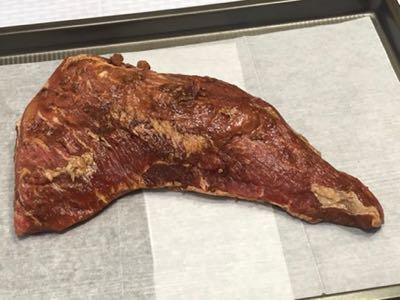
The brine helps to bring out the natural beef flavor but it’s also really good to add some seasoning to the outside, what will become the crust.
For this, I highly recommend my Texas style rub recipe.
Usually when we add seasoning, I recommend brushing on some vegetable or olive oil or even some yellow mustard to help the rub to stick however, if you add the seasoning just as soon as you remove it from the brine, the meat will be somewhat wet and the rub will stick to the meat really well.
After you season the top side of the meat and the edges, flip it over and season the bottom side as well.

Once seasoned, place the tri-tip on a Weber grill pan or a pan/rack for easy transport to and from the smoker. The meat can be left on the pan during the cooking process if you so desire or you can remove the meat from the pan and set it directly on the grate.
You'll notice another piece of meat on the pan below.. that's a tri-tip that was not cut properly.. as you can see, it's more square than triangle shaped as it should be. I got a good price on it and it was prime grade so I just dry brined that one to compare flavors.
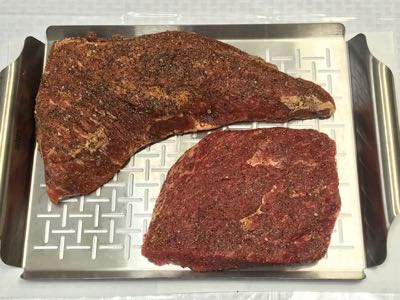
Set up your smoker for cooking at about 225°F using indirect heat. If your smoker uses a water pan, fill it up.
Traditionally, tri-tip is smoked with red oak but I have used pecan, post oak, cherry, apple and even a mixture of some of these and it always turns out great. This can be in the form of chips, chunks, pellets or large splits just depending on what type of smoker you are using.
I don’t say this often but maybe I should: there is no need to soak the smoking wood. This is something that is still touted in some smoker manuals, recipe books, and even on cooking blogs but there is absolutely no reason to do this.
Wet wood steams until it dries and then it produces smoke. Dry wood begins producing smoke a lot faster.
Once your smoker is heated to 225-240°F and holding steady, it’s time to place the meat in the smoker.
Place the meat or the pan of meat onto the smoker grate and close the door/lid.
If you are using a charcoal, electric or gas smoker, I recommend allowing the smoke action to continue for at least 1 hour and then it can be finished with just heat. It is also ok to apply smoke the entire time to simulate the flavor of a wood or pellet smoker.
Monitor the temperature of the tri-tip very carefully. I used the dual-probe “Smoke” by Thermoworks to monitor both pieces of meat at the same time.

At about the 110°F mark, melt a stick of butter (¼ lb) and stir in 1 heaping TBS of the Texas style rub .
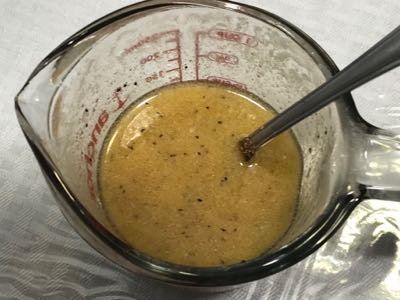
Baste the meat liberally with this mixture. Go ahead.. add some more! You can't go wrong with butter ;-)
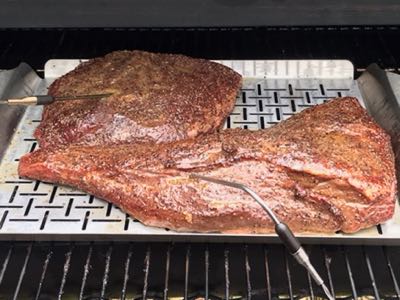
When it reaches 128-130°F or a perfect medium rare, remove it from the smoker.
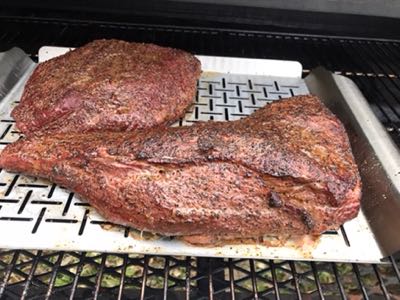
If you like your beef more done, be my guest but it will never be as good as it is at medium rare. The flavor, texture and juiciness degrades quickly beyond medium rare so tread carefully.
Let it rest with foil tented over the top on the cabinet for about 10-15 minutes before slicing or cutting into it. This allows the juices to redistribute throughout the meat and dissipates some of the pressure that has built up inside the meat during the heating process.

Slice the meat pencil thick across the grain noting that the grain does change directions about halfway through as shown in the image below.
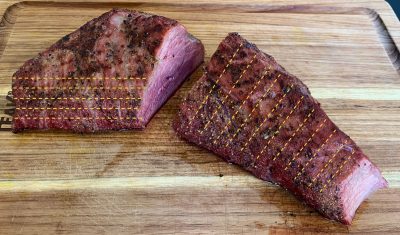
Serve immediately with plenty of vegetables and sides.
I mentioned earlier that I cooked (2) tri-tips.. one was a “square tip”.
The square one was dry brined with only salt for 3 hours in the fridge..
Here's an idea of the salt distribution that I used.
Note: If you want to measure, about ½ teaspoon of kosher salt per pound of meat is the correct amount for dry brining almost any cut of beef, pork, chicken, etc..

It was very good and had a slight advantage since it was prime grade whereas the other tri-tip was choice grade.
The tri-tip brined in the coffee had a more robust flavor but wasn't more salty than the dry brined one. Both of them were very similar in saltiness. I must stress that it wasn't overly salty at all. It had just enough to really bring out the natural flavors of the meat.
If you prefer, you can definitely use the dry brine technique and 2 hours is sufficient time but I recommend you try using espresso or coffee brine for your lean beef cuts. It doesn't taste like coffee when it's all said and done but it does add a little something extra to the meat.
Espresso Brined Tri-tip Smoked with Pecan
Ingredients
Main
- 3 lb tri-tip
- ¼ cup Jeff's Texas style rub
- 1 stick ((¼ lb) butter)
Espresso Brine
- 4 cups (1 quart) coffee
- ¼ cup coarse kosher salt (Morton’s blue box)
- 2 TBS cocoa (unsweetened)
- 1 TBS red pepper flakes
Instructions
- Trim the fat from the tri-tip using a sharp knife.
- Add the espresso brine ingredients to a ½ gallon pitcher or large bowl and stir well for about a minute or until the ingredients are dissolved into the liquid. If the coffee is still warm, the espresso brine will need to be cooled before use.
- Place the meat into a shallow container or even a 1- gallon sized ziptop bag and pour the brine over the meat to cover. Place in the fridge for about 3 hours.
- Remove the meat from the fridge after brining. Set the meat aside and discard the brining liquid. There is no need to rinse the meat.
- Season the top side of the meat and the edges with Jeff's Texas style rub, flip it over and season the bottom side as well.
- Set up your smoker for cooking at about 225°F using indirect heat. If your smoker uses a water pan, fill it up.
- Once your smoker is heated to 225-240°F and holding steady, Place the meat in the smoker and let it cook for approximately 2 hours with at least 1 hour of smoke action.
- At about the 110-115 degree mark, melt a stick of butter (¼ lb) and stir in 1 heaping TBS of the Texas style rub. Baste the meat liberally with this mixture.
- When the meat reaches 128-130°F or a perfect medium rare, remove it from the smoker and let it rest with foil tented over the top on the cabinet for about 10-15 minutes before slicing or cutting into it.
- Slice the meat pencil thick across the grain and serve immediately with plenty of vegetables and sides.

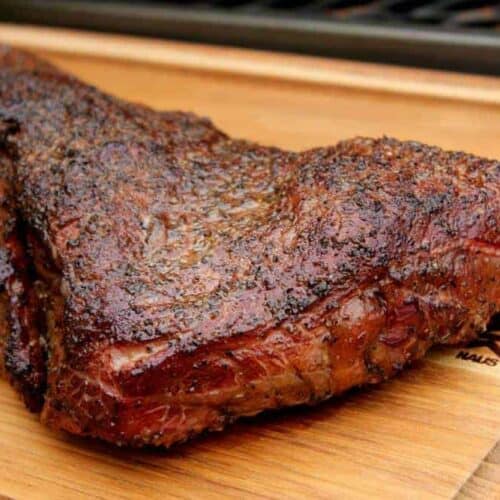
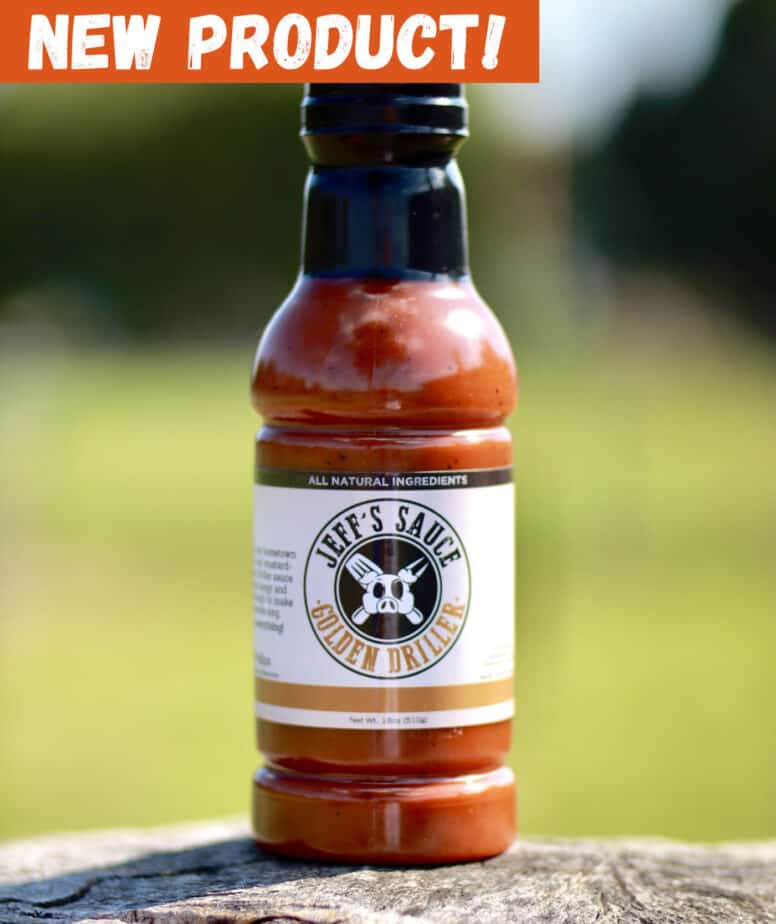
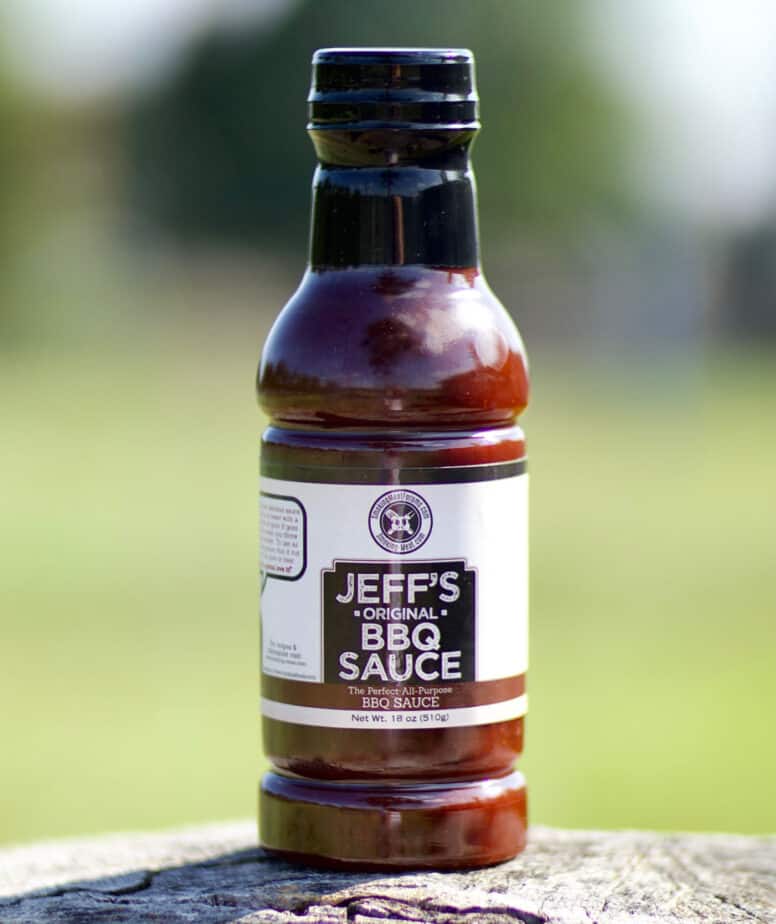
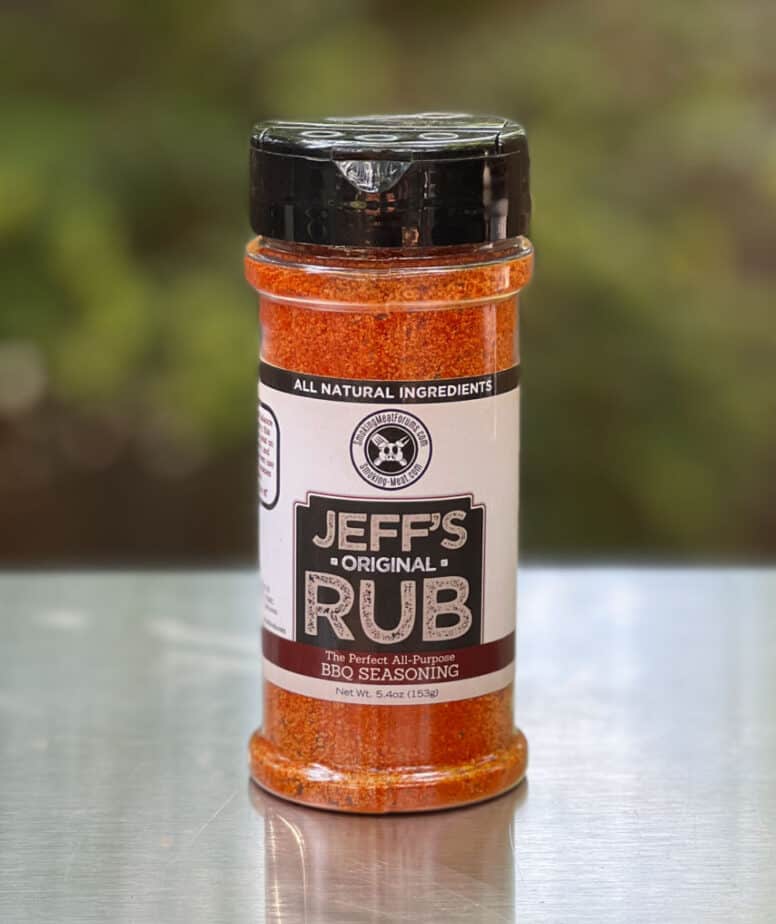
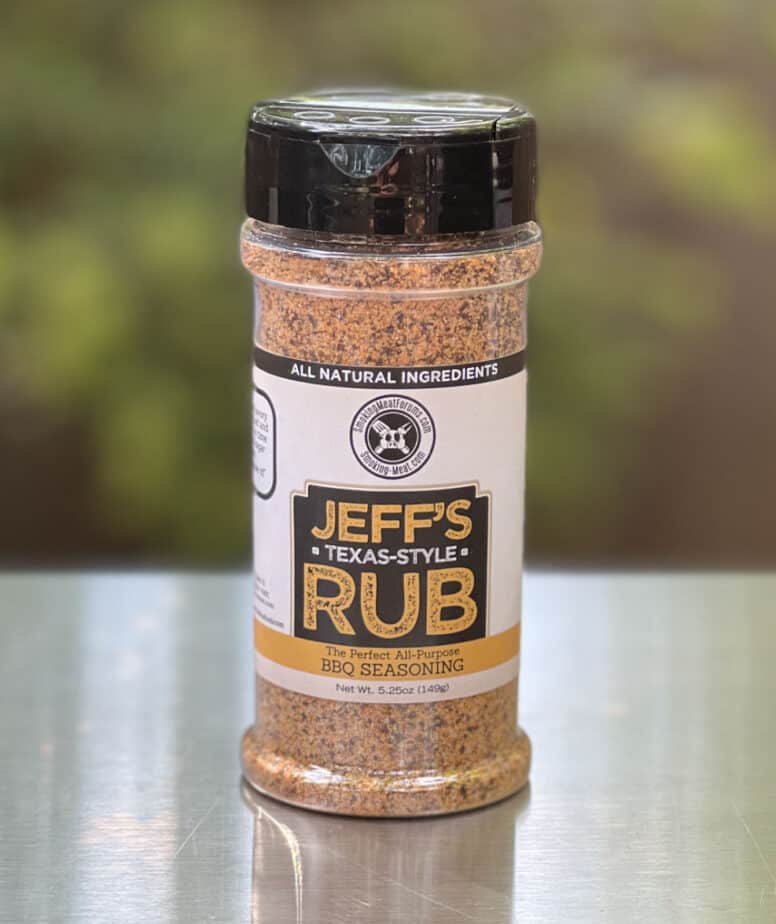
Great recipe!
I’d suggest you take a picture of your meat, pre brine, pre rub. This makes it easier to know how to cut across the grain when finished cooking!
It doesn’t say how much salt or cocoa so I just guessed. I bet it’ll be good anyways. It’s still marinating.
Valerie, the ingredients for the brine is in Step 2..
Let me know if you need further help with this.
Thank you for the measurements. You should update this recipe to include that in step 2
Ruby, I have corrected the ingredients on the recipe card to include the espresso brine.
I Love this its cold here in Maine so I tried this on a Weber Charcoal unit, indirect heat ! WOW is all I can say and It passed the Wife test hands down ! as soon as we get a mid winter day Ill do this on my offset smoker Thanks for the Tip or should I say thanks for the tri-tip tip ! If I could Id post a Picture!
OMG!! I saw this recipe come across my email and it sounded interesting, so I decided to give it a try.
Was t sure at first how it was gonna taste so I tried it on a small cut of Tri Tip. Big mistake! I barely got a piece before the Family gobbled it down!
It received two thumbs up from everybody. I will definitely be making this again real soon.
Thanks Jeff!!
Love me some Tri-Tip. What I especially love about it is that due to shape of the meat, you can satisfy people that enjoy different doneness. The wife likes medium, and I like medium rare to rare. When I slice it, she gets the smaller, pointed end and that’s usually about medium. I get slices from the part that gets thicker and it’s usually medium rare. The thickest part is usually leaning towards rare, and that makes great sandwiches the next day. I just slice it thin and put it in a ziplock bag with the board juices. I have to say, I actually like the cold sandwiches better the next day.
Never used a coffee marinade or rub before (on anything), I’ll have to make it one of these days.
Used this espresso brine on my Christmas Prime Rib. Outstanding! Double the recipe and brine overnight in a large stockpot. You won’t be sorry.
Would this work on a whole beef brisket? I’m still new to the smoking world and not that familiar with my cuts of meat. Brisket probably is not considered “lean” as you mentioned in a previous comment but thought I would ask.
Kevin, I have not tried this particular brine on a brisket but it should work great. The brisket is fattier and has more connective tissues and for this reason, must be cooked much longer and to a higher internal temperature before it is tender and ready to eat.
‘Espresso-brine’ sounded intriguing when I first read the title, but saw the ingredients listed 4 cups of coffee (not espresso). Big difference in strength and boldness of flavor. I suppose “Coffee-Brine” isn’t as exotic sounding but it is what it is. Being both a coffee and espresso lover, I still look forward to giving this recipe a go! Thanks!
I’m with you on the difference between espresso and coffee.. I love my espresso shots in the morning to get my day started with a bang. Thing is, in cooking, the words “espresso” and “coffee” are often used interchangeably as if they are one and the same. You can definitely use the stronger strength espresso if you are feeling crazy and bump up that coffee vibe a few notches. My advice, use whatever you are used to drinking and can make in a large enough quantity to use it for brining.
Hey Jeff. Love me some Tri-Tip and this recipe looks tasty. I’ll have to give it a try. One thing I have found that people do wrong with this cut of meat is the slicing. The grain in a properly cut Tri-Tip actually runs in three different directions (see the image linked below). What I might suggest is that you add an image similar to that one, and tell them to cut across the white lines in the image.
https://goo.gl/images/FNF3Sa
Thanks for the great info!
Happy Holidays!
Terry
I tried this a couple of months back and now have cooked it 4 times and has become a favorite thanks Jeff for sharing your recipes
Jeff, would your original rub work in place of the Texas style rub? Thanks
Yes, I have used the original rub on tri-tip many times and it’s very good. You could also use my original rub with some coffee in it as recommended at https://www.smoking-meat.com/october-10-2013-coffee-brined-smoked-baby-back-ribs. It’s basically ¾ cup of my original rub with ¼ cup of finely ground coffee mixed in.
Just spiballing here, but what if you were to make the espresso with heavy whipping cream and then added just a weebit of baking soda to the brine?
Paul, I have not used heavy whipping cream in the espresso brine but I have used buttermilk and other dairy products so I don’t think it would hurt anything. There are enzymes in the milk that help to tenderize the meat.
I also have not experimented much with baking soda however it does has a tenderizing effect and many chefs claim that it helps the meat to crisp up better during the cooking process.
I’d be interested to hear out this goes if you have the time.
I cannot find tri-tip in my area. I saw that you recommend any lean, tender cut. I don’t know my cuts good enough… could you please suggest your top 2 or 3 alternative cuts?
Jeff,
I owned a business for 28 years and amoung many other products, we sold many brands of grills and smokers, including many trailer smokers. We also competed in many bar-b-q competitions in Kansas City and other sanctioned events in Oklahoma and Kansas. I am friends with many national and even world champions. I say all of that to let you know that I really value your emails. You do a great job all around. Your information and techniques are valuable to folks at all levels of expertise.
I have purchased your sauce and spice recipes and use them all of the time. But, I have either lost your Texas style recipe, or perhaps I have never had it? Is it purchased seperately? I have never used it and would like to try it. Please let me know if I need to purchase it.
Thanks. Keep up the good work!
Larry D. Cox
I missed this before the holidays.. for that I apologize. I just re-sent the download email, which contains the original and Texas rub recipe as well as the sauce recipe, so you’ll have it from now on. Let me know if you need further help with this.
OMG this is good! Never had tri tip before but this recipe sounded so good I had to try it! Boy am I glad I did! Thank you!
I tried the Tri Tip Coffee Brine and used the Texas Rub. Holy “smokes”!!! It was excellent. However…I did have leftovers. So I decided to slice them up into bit size pieces and pan fry in a cast iron skillet to reheat, fried up some corn tortillas to make homemade taco shells and ate some of the best tacos I ever put in my mouth.
Have you tried this method with a beef tenderloin?
I have not tried this with a beef tenderloin but I think it would be excellent. Any lean, tender steak would work great with this brine and this method.
What type of coffee did you use? was it an instant espresso or ground beans and then dripped coffee?
I used a dark roast semi-fine grind.. not quite espresso. Any coffee will work.. I prefer the dark roast for sure.
Thank you so much for helping me become A better cook by being able to smoke food. I have a yoder Cheyenne offset now. Thanks alot